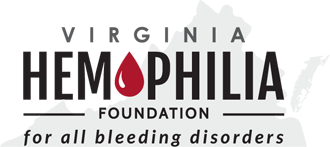Bleeding Disorders
Bleeding disorders are a group of disorders that share the inability to form a proper blood clot. Symptoms include extended bleeding after injury, surgery, trauma, or menstruation. Sometimes the bleeding is spontaneous, without a known or identifiable cause. Improper clotting can be caused by defects in blood components such as platelets and/or clotting proteins, also called clotting factors. If any of the 13 clotting factors are defective or deficient, blood clotting is affected; a mild, moderate, or severe bleeding disorder can result.
Hemophilia
Hemophilia A, also called factor VIII (8) deficiency and Hemophilia B, also called factor IX (9) deficiency, are genetic disorders caused by missing or defective clotting protein. Although both are passed down from parents to children, about 1/3 of cases found have no previous family history.
According to the US Centers for Disease Control and Prevention, hemophilia occurs in approximately 1 in 5,000 live births. There are between 30,000 – 33,000 people with hemophilia in the US. All races and ethnic groups are affected, and women can and do have hemophilia and/or bleeding disorders. Despite long-standing misconceptions about bleeding disorders in women, women’s voices and experiences are now being taken more seriously.
von Willebrand disease
von Willebrand disease (VWD) is an inheritable bleeding disorder and people with VWD are either missing or low in the clotting protein von Willebrand factor (VWF) – or it doesn’t work as it’s supposed to. VWD is the most common bleeding disorder and occurs equally across all races and ethnicities affecting up to 1% of the US population – or approximately 1 in every 100 people. It occurs equally in men and women. However, women may be more symptomatic due to heavy menstrual bleeding.
National Outreach for von Willebrand (NOW) Conference is a national educational conference for individuals and families who are living with this chronic disorder. Go here to learn more.
Resource List:
- NBDF Webinar – New Guidelines for VWD: Patient Perspective
- NBDF Iron Deficiency and Anemia: An Underappreciated Complication in von Willebrand Disease
- The Hemophilia Society: Understanding VWD
- US Dept. of Health and Human Services: The Diagnosis, Evaluation, and Management of von Willebrand Disease
- CDC VWD Stories
- Cincinnati Childrens’s: Misconceptions about Von Willebrand Disease in Teen Girls
- VWD Connect Resorce Page
- WFH Webinar on von Willebrand Disease
Platelet disorders
Platelet disorders are conditions in which platelets, cells in the blood that bind together to make a clot, do not work properly.
Rare Factor Deficiencies
Rare Factor Deficiencies such as I, II, V, VII, X, XI, XII and XIII, are all rare disorders. Factor deficiencies are defined by which specific clotting protein in the blood protein is low, missing or doesn’t work properly. These very rare factor deficiencies were only identified within the last 60-70 years. Go here to learn more and go here for educational resources.
Patient Out-of-Pocket Expenses For patients with chronic diseases like bleeding disorders out of pocket expenses for prescription drugs are a significant concern. The average annual cost of clotting factor therapies for a person with severe hemophilia is roughly $300,000. Medical expenses for a person with severe hemophilia, the most common form of hemophilia, can be twice that. A person with an inhibitor (an immune response to replacement clotting factor) usually has expenses over a million dollars a year.
The treatment needs of a person with a bleeding disorder lasts throughout their lifetime and do not typically vary during the year. Patients need access to replacement clotting factor or other non-factor therapy year ‘round. Even the “average” hemophilia patient incurs tens of thousands of dollars of expenses monthly due to the treatment.
Treatment Comprehensive Medical Care treats the whole person and the family, through continuous supervision of all the medical and psychosocial aspects of bleeding disorders. Comprehensive care is total care because every facet of the person is addressed, including their physical, emotional, psychological, educational, financial, and vocational factors. The development of comprehensive care over the past 30 years has greatly improved the quality of life for people with bleeding disorders, helping them to be more independent and productive. The hemophilia treatment center care network has also improved patient’s overall health.
Hemophilia Treatment Centers (HTCs) Although they are called hemophilia treatment centers, HTCs provide treatment for people with VWD and other bleeding disorders and access to comprehensive care through a team of multidisciplinary healthcare professionals that emphasize prevention to help reduce or eliminate complications. Even though inherited bleeding disorders can lead to chronic health problems, people can live a long, healthy life if the disorder is managed properly. HACA and VHF collaborate closely with the 4 federally funded HTCs in Virginia. » Go here for a list of HTCs in Virginia
Importance of Access to Care There is no cure for hemophilia and other related bleeding disorders. Prior to the ACA, people with bleeding disorders were discriminated against in the insurance market. Insurance plans could exclude from coverage people with preexisting conditions. The elimination of lifetime and annual limits on insurance benefits was a significant consumer protection for people living with bleeding disorders. As a result of the high-cost treatments, people with bleeding disorders would routinely hit lifetime and annual limits before the ACA.
Fast Facts
Read VHF’s Fast Facts about Bleeding Disorders »

